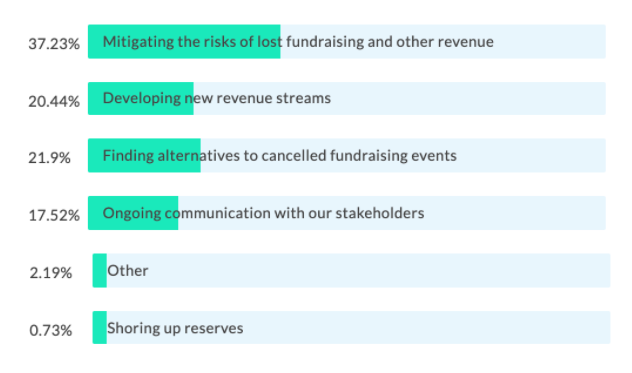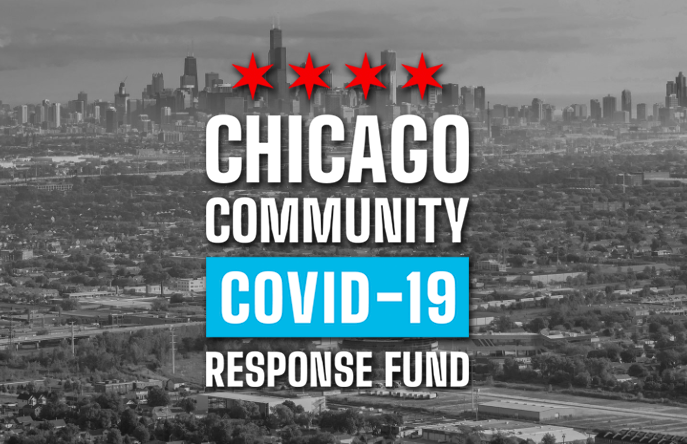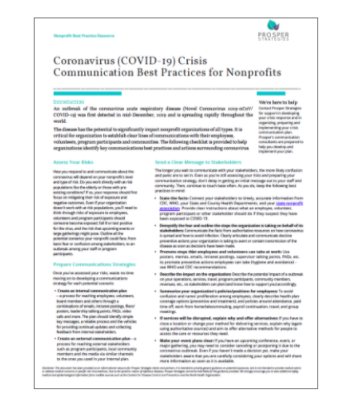On last week’s webinar, when we asked the nonprofit leaders in attendance what they were most worried about right now, in light of COVID-19, “mitigating the risk of lost fundraising revenue” ranked as their number one response.
 That’s no surprise. With the virus gaining momentum in the midst of fundraising events season, thousands of nonprofits across the country have had to cancel their galas, walks, and other fundraising events and say goodbye to the revenue those events bring in. Still more organizations have seen individual and corporate donations decline as nervous Americas tighten their belts in reaction to a tanking economy. You might be among either or both of those groups. If you are, we’re thinking of you, and we’re here for you.
That’s no surprise. With the virus gaining momentum in the midst of fundraising events season, thousands of nonprofits across the country have had to cancel their galas, walks, and other fundraising events and say goodbye to the revenue those events bring in. Still more organizations have seen individual and corporate donations decline as nervous Americas tighten their belts in reaction to a tanking economy. You might be among either or both of those groups. If you are, we’re thinking of you, and we’re here for you.
At the same time as resources are shrinking, the demand for the services provided by nonprofits like yours are growing. So many people who live paycheck to paycheck are finding themselves out of work and unable to meet their basic needs due to closures and shelter in place orders, and they’re turning to the nonprofit sector for help.
Sustaining operation in an environment of increasing demand and decreasing resources is not going to be easy for many nonprofits, especially given that before this crisis began, more than half of 501(c)3 organizations had less than three months of reserves and 10 percent had less than a month’s worth. That’s not a significant runway in the face of an unprecedented public health crisis and economic downturn like this one.
All this said, I truly believe that most organizations can make it through this crisis and come out on the other side stronger than ever. But if you hope to do so, you’re going to need to make smart decisions now (not next week or next month) to shore up your reserves, and finding a way to keep fundraising revenue coming in is a key part of that equation.
Here are 11 things you can do right now to mitigate the risk of lost fundraising revenue and keep money coming in for your organization. Some of these ideas might even help you do more than survive this crisis – they’ll help you turn it into a new opportunity for engagement and growth.
Don’t Stop Fundraising
This might seem obvious, but now is not the time to hit the breaks on your fundraising efforts. Instead, it’s the time to adjust to the circumstances and fundraise differently. It’s the time to get smarter, more strategic, and most of all more human in your interactions with donors. Re-calibrate your plans for the year based on what you learn in the rest of this post, but make that a quick exercise, and then get back to work. There is no time to waste.
Connect Directly With Your Donors
Many donors are unsure how to step in and help the nonprofit sector and the people who need its services most in the face of the COVID-19 outbreak. The National Center for Family Philanthropy reports they are “hearing from wealthy donors and families who are feeling compelled to address this crisis, but there’s a lot of uncertainty of how to do that.”
Don’t leave your donors guessing. Instead, do everything in your power to let them know what your organization needs and how they can help. Communicate honestly about your nonprofit’s current status and the challenges you expect to face in the weeks and months ahead. That might even mean telling your supporters directly that your organization might not have enough money to survive if the crisis escalates and sharing what your runway is with them. Yes, these can be uncomfortable conversations, but you’ll be amazed by how people step up if you are transparent.
Make an Authentic Connection Between COVID-19 and Your Mission
Do your donors understand why supporting your organization is especially important now, in light of the growing threat of COVID-19? For some of you, making this connection is a no-brainer, because you are directly addressing the crisis through your work in healthcare, public health or human services. But even if your organization is not on the front lines, there is a good chance that your work is either impacting, or impacted by, this crisis. Of course, we’d never advise that you take advantage of this situation in a way that is disingenuous or opportunistic, but you should absolutely acknowledge the role your work plays in helping the lives affected by coronavirus (whether directly or by loss of income), and the way your revenue is impacted by the resulting downturn. For example, animal shelters are sharing reports of an increased number of surrendered pets due to families that have lost their jobs and can no longer afford to care for their animals, and performing arts organizations are sharing transparently about lost income to their valued performers.
Make Specific Asks
One way to make the connection between your cause and COVID-19 is through a specific, highly focused ask. One client of ours, a human services organization with over a dozen programs, was struggling to articulate their increased need in response to this crisis on an organization-wide level. Instead, they chose to make a specific ask for a small subset of their client base: parents of babies and toddlers. Many of the parents the organization serves are struggling to afford diapers and formula right now in the midst of the coronavirus crisis, so the organization asked for support specifically to fund those purchases, and raised over $5,000 in a single day. They plan to report back on the number of families helped and bottles of formula and diapers purchased as the result of these generous donations. Down the road, they plan to forge deeper connections with the donors who took action during this time of great need.
Pursue Emergency Response Funds, DAFs and Unrestricted Grants From Foundations
While keeping individual donations going is important, if I were fundraising, I’d put most of my energy into pursuing emergency response funds (like the Chicago COVID-19 Response Fund – disclosure: we are working on the PR for the fund), donor advised funds, and unrestricted grants from foundations right now. Based on data from 9/11 and the 2008 recession, we know that these funding sources tend to perform better in times of a crisis or recession. When it comes to finding emergency response funds specifically for nonprofits, your state nonprofit association is a good place to start.
 I’d also ask for flexibility from grantmakers who you already have relationships with. For example, you could ask for previously restricted funds to be made unrestricted, request accelerated funding schedules or ask for grant requirements to be lightened. If you’ve already had success with corporate partnerships, workplace giving initiatives or corporate grants, don’t walk away from those funding sources now. Instead, see how you can position continued support of your organization as a strong PR move for a company that has the means and desire to do good. But recognize that many for-profit businesses are feeling the pain as much as nonprofits right now. Be thoughtful about who you reach out to (restaurants are out, for example) and be sensitive in your ask.
I’d also ask for flexibility from grantmakers who you already have relationships with. For example, you could ask for previously restricted funds to be made unrestricted, request accelerated funding schedules or ask for grant requirements to be lightened. If you’ve already had success with corporate partnerships, workplace giving initiatives or corporate grants, don’t walk away from those funding sources now. Instead, see how you can position continued support of your organization as a strong PR move for a company that has the means and desire to do good. But recognize that many for-profit businesses are feeling the pain as much as nonprofits right now. Be thoughtful about who you reach out to (restaurants are out, for example) and be sensitive in your ask.
Acknowledge The Circumstances
When communicating with donors and funders, don’t pretend that anyone is experiencing “business as usual”. Acknowledge the severity of the COVID-19 crisis, and the fact that it might not be a good time for donors to give right now, but that you appreciate their ongoing dialogue and support. Many donors will appreciate this candor and come back to you when they can give.
Know That There Are Still Donors Out There
The economic impact of this crisis is already huge and the full extent of it remains to be seen. But as hard as it might be to imagine right now, some people will actually do well financially as a result of the recession that is likely coming our way. Some industries are actually benefiting from things like remote work policies (think Slack, GotoMeeting and Zoom), and their leadership and employees stand to gain a great deal as a result. On an individual level, it’s likely that some investors will bet on the stock market when it is down and make a lot of money when things begin to turn for the better. Remember that these donors are out there, and many of them will want to help you in the weeks and months ahead.
Touch In Often (But Don’t Ask Every Time)
You never know who will have the capacity to give when. As this crisis continues to evolve, communicate with your donors and prospective donors frequently (as often as weekly or biweekly), but don’t make every communication an ask. Your supporters want to hear from you about how your organization is faring, adjustments you’re making, and needs that are continuing to crop up. Thank them for their generosity and caring, let them know what you’re up to, and stay on their radar so that when they can give, your organization is top of mind.
Focus on Donor Acquisition
I also feel strongly that now is the time to focus on donor acquisition. Even before this crisis, due to demographic shifts and increased competition, many of our clients were seeing their donor bases decrease, and that trend is highly likely to continue now. One creative tool we’ve used for donor acquisition is content-focused Facebook lead gen ads. We’ll create a downloadable resource related to our client’s mission, like the one you see here, a guide to doing good and giving back in Chicagoland. We’ll then advertise it using Facebook’s lead gen ad format to Facebook users who have behaviors and interests that indicate they’ve given to other similar organizations and might give to our client. These users have to provide their contact info in order to get the resource, and we can then nurture them toward giving through emails and other communication. A method similar to this one could be a great way to identify people who are looking for ways to help amidst the COVID-19 crisis.
Expand Your Thinking About What Fundraising Means
Traditional direct mail and digital campaigns might be especially challenging right now, but your development department can expand the scope of its revenue-generating activities during the crisis. Perhaps now is the time to start that social enterprise arm of your nonprofit you’ve always dreamed of. For example, let’s say you’re a human services organization that offers counseling. You could offer fee-based online sessions for those experiencing social isolation during this lockdown/work from home time, and your development team could spearhead the communications around this effort.
Move Your Fundraising Events Online
Rather than canceling your gala, walk, or fundraising event altogether, consider moving it online. There are great platforms (such as OneCause and Bidding Owl) that can replicate the experience of a paddle raise, silent or live auction, timed appeal, etc. And with social distancing and video gatherings becoming the new normal, you might be shocked at just how many people are excited to get involved online.
How We Can Help
This post is part of our ongoing, emergency series: coping with COVID-19 in the nonprofit sector. In the coming weeks, we’ll be sharing more content like this through both our blog and live webinars. Is there a challenge you’d like us to address? Reach out to alyssa@prosper-strategies.com and we’ll do our best to work it in. Find all our COVID-19 resources here, if you need more hands-on help, here’s how we might be able to pitch in.
Resource: Coronavirus Crisis Communications Checklist for Nonprofits
You are likely face difficult decisions about whether to cancel or reschedule upcoming events, quarantine exposed staff and volunteers, allow remote  work, limit employee travel, change service delivery methods, and more. Your stakeholders expect answers about what you’re doing to mitigate risks for your employees, volunteers, and program participants, and it is your responsibility to provide those answers.
work, limit employee travel, change service delivery methods, and more. Your stakeholders expect answers about what you’re doing to mitigate risks for your employees, volunteers, and program participants, and it is your responsibility to provide those answers.
To help you with these hurdles, we’ve created a one-page checklist of coronavirus crisis communications best practices for nonprofits. Access your copy here: